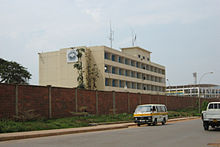In 1995, it became located in Arusha, Tanzania, under Resolution 977.[3] (From 2006, Arusha also became the location of the African Court on Human and Peoples' Rights). In 1998 the operation of the tribunal was expanded in Resolution 1165.[4] Through several resolutions, the Security Council called on the tribunal to complete its investigations by end of 2004, complete all trial activities by end of 2008, and complete all work in 2012.
 |
| An ICTR building in Kigali, Rwanda. |
The tribunal has jurisdiction over genocide, crimes against humanity, and war crimes, which are defined as violations of Common Article Three and Additional Protocol II of the Geneva Conventions (which deals with internal conflicts).
As of 2009, the tribunal had finished 50 trials and convicted 29 accused persons, and another 11 trials were in progress and 14 individuals were awaiting trial in detention; but the prosecutor intends to transfer 5 to national jurisdiction for trial. 13 others are still at large, some suspected to be dead.The first trial, of Jean-Paul Akayesu, began in 1997. Jean Kambanda, interim Prime Minister, pleaded guilty. According to the ICTR's Completion Strategy, in accordance with Security Council Resolution 1503, all first-instance cases were to have completed trial by the end of 2008 (this date was later extended to the end of 2009[7]) and all work is to be completed by 2010. It has recently been discussed that these goals may not be realistic and are likely to change.  The United Nations Security Council called upon the tribunal to finish its work by 31 December 2014 to prepare for its closure and transfer of its responsibilities to the International Residual Mechanism for Criminal Tribunals which will begin functioning for the ICTR branch on 1 July 2012. As of spring 2015, the Residual Mechanism had taken over much of the operations of the tribunal, and the tribunal announced on February 2, 2015 that it was significantly reducing staff with the goal of wrapping up operations and closing the tribunal by the end of 2015.[8] The Tribunal was officially closed on 31 December 2015.
The United Nations Security Council called upon the tribunal to finish its work by 31 December 2014 to prepare for its closure and transfer of its responsibilities to the International Residual Mechanism for Criminal Tribunals which will begin functioning for the ICTR branch on 1 July 2012. As of spring 2015, the Residual Mechanism had taken over much of the operations of the tribunal, and the tribunal announced on February 2, 2015 that it was significantly reducing staff with the goal of wrapping up operations and closing the tribunal by the end of 2015.[8] The Tribunal was officially closed on 31 December 2015.
In March 2010, the ICTR announced plans to digitize all video recordings of the trials, both audio and video, in all three languages (English, French, Kinyarwanda). This is part of a larger project that included digitizing audio recordings.
Establishment of the ICTR
The United Nations Assistance Mission for Rwanda is regarded as a major failure. The international response to the Rwandan Genocide was poor. For weeks, the major power nations denied that a genocide was taking place in Rwanda. Even, the United States refused to call the incident "genocide," because using the term would make an obligation for the United States to send troops. Finally in July 1994, long after the genocide was over, the UN Security Council called for an investigation of the events, and acted to establish an international criminal tribunal to prosecute those individuals most responsible for the genocide. Adopting Resolution 955, the Security Council created the ICTR on 8 November 1994 and the ICTR would also deal with other crimes against international humanitarian law committed on the territory of Rwanda and neighboring states between 1 January 1994 and 31 December 1994
ICTR Structure
The tribunal consists of 16 judges in four "chambers" - three to hear trials, and one to hear appeals. In addition, there are 9 ad litem judges, making 25 in all. At present, all 9 ad litem judges are assigned to Chambers II and III. There is an additional pool of 9 further ad litem judges who may be called on in the case of a judge being absent.
Comments
Post a Comment